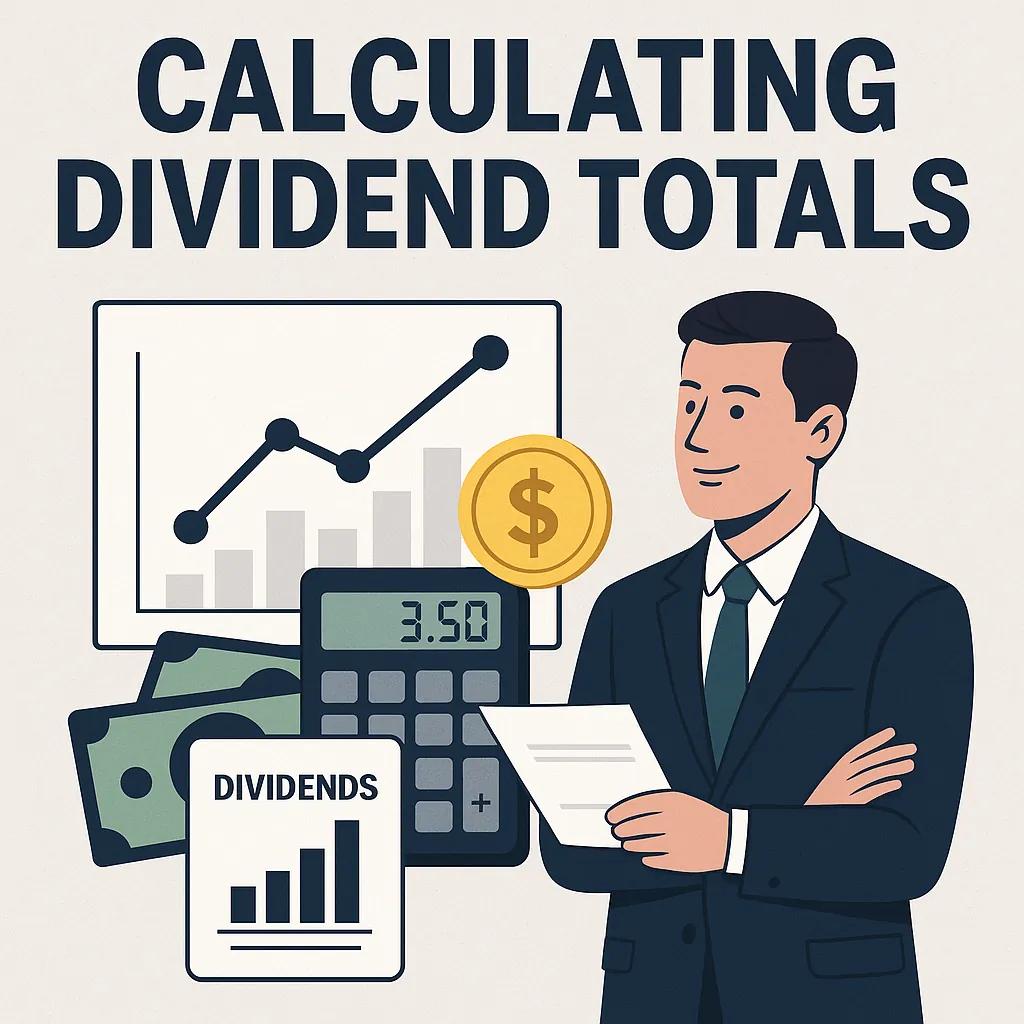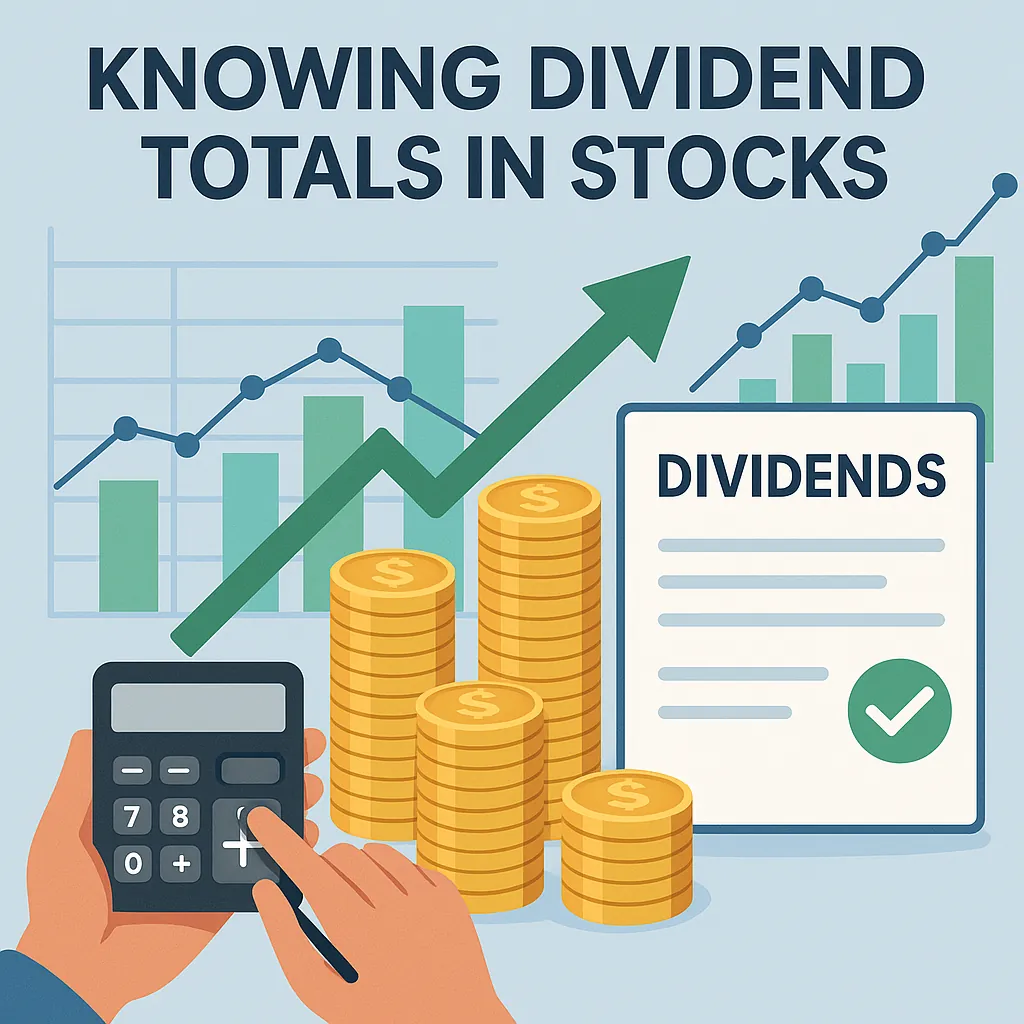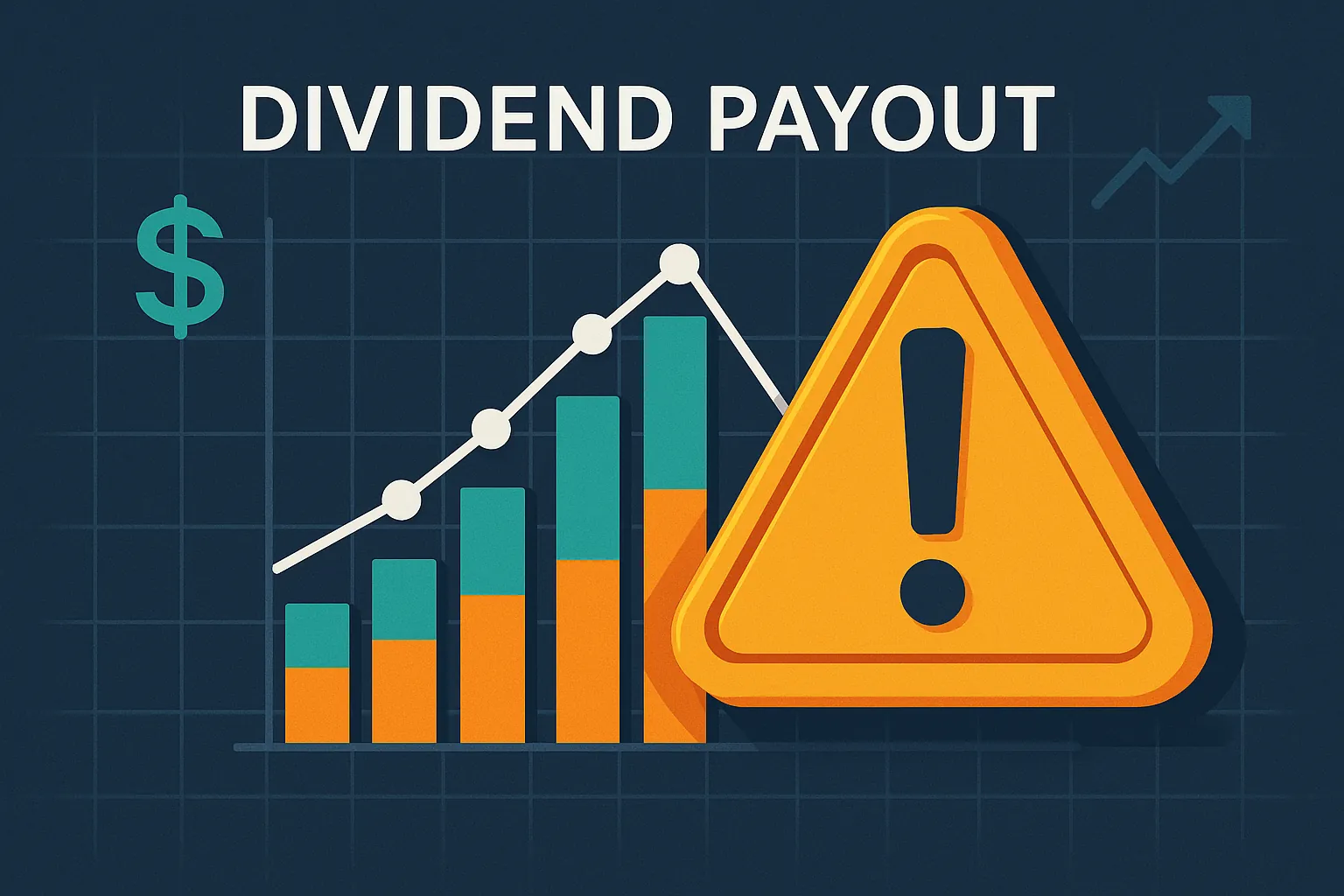
Knowing Dividend Totals in Stocks — A Proven Strategy for Consistent Income
This guide reveals how knowing dividend totals in stocks can transform your portfolio from unpredictable to a steady passive income machine. You’ll learn formulas, tracking methods, real-world examples, expert strategies, and how to apply this knowledge for consistent returns—even in volatile markets.
Why Dividend Totals Matter More Than You Think
Most investors chase stock price growth while overlooking dividend totals—the cumulative cash payouts that, over years, can exceed the original share purchase price. Understanding these totals gives you a clearer picture of total shareholder return (TSR), combining both capital appreciation and income.
According to Investopedia’s guide to dividend investing, dividends have historically contributed up to 40% of total stock market returns in certain decades. Yet many traders treat them as an afterthought, focusing solely on short-term price movements.
At TradeStockAlerts.com’s dividend income strategy guide, we emphasize the importance of **tracking dividend totals** as part of your investment checklist. Whether you’re building a retirement portfolio or funding monthly expenses, understanding the flow of cash from your investments is just as vital as monitoring their market value.
📌 Key Takeaways
- ✅ Dividend totals compound wealth over decades when reinvested.
- ❌ Ignoring dividend payouts can mean missing a significant portion of market returns.
- ✅ Dividend stability often signals a company’s financial health.
✔️ Pros & ❌ Cons
| ✅ Reliable passive income source | ❌ May be overlooked during bull markets |
| ✅ Often linked to strong, stable companies | ❌ Can lead to complacency if investors ignore stock fundamentals |
How to Calculate Dividend Totals Accurately
Knowing the exact dividend totals a stock will generate over time is a game-changer for income-focused investors. By mastering this calculation, you can set realistic expectations for annual cash flow and long-term portfolio growth.
The two key metrics every investor must track are:
- Dividend Yield – the annual dividend per share divided by the current share price.
- Payout Ratio – the percentage of a company’s earnings paid out as dividends.
According to Morningstar’s dividend yield guide, a sustainable yield often falls between 2%–6% for most blue-chip companies. A payout ratio above 75% can signal potential risks to dividend stability.
At TradeStockAlerts.com’s stock type comparison, we explore how common vs. preferred shares can yield different dividend structures. Preferred stocks often offer higher fixed yields, while common stocks may have variable but growing payouts over time.
📊 Sample Dividend Totals Comparison
| Company | Share Price | Annual Dividend | Dividend Yield | 5-Year Total Dividends |
|---|---|---|---|---|
| Company A | $50 | $2.50 | 5% | $12.50 |
| Company B | $80 | $3.20 | 4% | $16.00 |
| Company C | $100 | $5.00 | 5% | $25.00 |

Image: Minimalist 3D-style chart comparing dividend totals of three companies over five years.
✔️ Pros & ❌ Cons
| ✅ Easy to project income for planning purposes | ❌ Can be misleading if company cuts dividends |
| ✅ Helps identify reliable income-generating stocks | ❌ Doesn’t account for share price fluctuations |
Real‑Life Case Studies of Dividend Success
Nothing proves the power of knowing dividend totals in stocks like real numbers from disciplined investors. Below are three concise, data‑driven stories showing how tracking and optimizing dividend totals can turn modest accounts into dependable cash‑flow engines.
Case Study #1 — The $10K “Paycheck Builder”
Starting capital: $10,000 in a diversified basket of dividend stocks averaging a 4.2% yield, with dividends reinvested quarterly.
Five‑year outcome: Dividend totals of roughly $2,600–$3,200 received (depending on drip pricing), plus principal growth from steady reinvestment.
The investor followed a simple rule: focus on sustainable yields, not the highest yield on the screen, and reinvest by default. This mirrors the beginner‑friendly approach in building a diversified portfolio with small amounts:contentReference[oaicite:0]{index=0} and the mindset that owning stocks means owning real businesses:contentReference[oaicite:1]{index=1}.
Case Study #2 — Reinvest & Grow: The 8‑Year Doubler
Starting capital: $15,000 in a mix of dividend growers (initial yield ~3%).
Playbook: Target companies with consistent dividend increases and healthy payout ratios; auto‑reinvest dividends; add small monthly contributions during dips.
Over eight years, the investor’s annual dividend total grew from ~$450 to ~$1,150 as payouts increased and share count rose via DRIPs. The philosophy aligns with fundamentals like those covered in understanding the real value of a stock:contentReference[oaicite:2]{index=2} and keeping a long‑term lens.
Case Study #3 — The “Bills‑Paid” Dividend Ladder
Goal: Match monthly bills with dividend cash flow within 5–7 years.
Method: Allocate across sectors (utilities, consumer staples, pipelines, REITs), map ex‑dividend dates to stagger income, and prioritize sustainability over headline yield.
The investor tracks a rolling 12‑month dividend total, celebrating each milestone (first $100/mo, then $250, then $500). For new investors ramping up, a primer like the Stock Market for Dummies PDF:contentReference[oaicite:3]{index=3}helps establish the baseline skills to execute this plan.
📊 Mini Snapshot: Dividend Totals & Momentum
| Profile | Initial Yield | Years | Dividends Collected | Notes |
|---|---|---|---|---|
| $10K Paycheck Builder | 4.2% | 5 | $2.6k–$3.2k | DRIP + steady screens |
| 8‑Year Doubler | 3.0% | 8 | >$7k cumulative | Dividend growth focus |
| Bills‑Paid Ladder | 3.5%–5.5% | 6 | $5k–$6.5k | Sector staggering |
As your dividend totals rise, remember to review business quality and risk. These concepts pair well with cutting through market noise with a simple process:contentReference[oaicite:4]{index=4} so you stay focused on reliable cash flow.
✔️ Pros & ❌ Cons (From the Case Studies)
| ✅ Real cash flow that can be scheduled against bills | ❌ Requires patience; compounding isn’t dramatic month‑to‑month |
| ✅ Reinvestment (DRIP) accelerates growth without extra decisions | ❌ Dividend cuts can slow progress if quality screens are weak |
📌 Key Takeaways
- Track a rolling 12‑month dividend total to measure true income momentum.
- Favor sustainability over headline yield; dividend growth compounds share count and payouts.
- Use internal education like this beginner primer:contentReference[oaicite:5]{index=5} to reinforce best practices as totals rise.
Expert Insights on Maximizing Dividend Income
Learning from the strategies of seasoned dividend investors can help you accelerate your income growth while avoiding common traps. From fund managers to veteran retail investors, experts stress that dividend totals are most powerful when combined with disciplined reinvestment and careful stock selection.
According to Nasdaq’s guide to high dividend stocks, the safest income streams come from companies with a long history of paying and increasing dividends, even during market downturns. But experts also warn against over-concentration in a single sector, no matter how strong its dividend yield appears.
On TradeStockAlerts.com’s penny stock analysis:contentReference[oaicite:0]{index=0}, risk-versus-reward is a central theme. While penny stocks can offer high yields, they often carry higher volatility and payout uncertainty, making them a poor fit for conservative dividend portfolios.

Image: 3D-style depiction of an expert panel sharing dividend strategies, set against a backdrop of financial performance charts.
✔️ Pros & ❌ Cons of Following Expert Dividend Strategies
| ✅ Access to research and insights not easily available to the public | ❌ Experts can still be wrong — no forecast is perfect |
| ✅ Helps refine portfolio strategy with proven frameworks | ❌ Some strategies may require larger capital to implement fully |
📌 Key Takeaways
- Focus on companies with a long history of dividend growth and strong fundamentals.
- Use expert insights as guidance, not gospel — verify with your own research.
- Blend high-yield and dividend growth stocks to balance income and appreciation potential.
Building a Dividend‑Focused Portfolio (Screen, Select, Structure)
A great dividend portfolio isn’t an accident—it’s a screened, selected, and structured mix of businesses that can keep paying you through thick and thin. Below is a practical, step‑by‑step framework to build a durable income engine while staying true to the theme of knowing dividend totals in stocks.
Step 1 — Screen for Quality & Sustainable Payouts
- Profitability & cash flow: Favor companies with consistent free cash flow that comfortably covers the dividend.
- Payout ratio trend: A stable or declining payout ratio signals room for future increases.
- Dividend growth history: Multi‑year increases show commitment to shareholders.
- Balance sheet: Reasonable leverage (net debt/EBITDA) supports resilience in downturns.
If you’re new to screening fundamentals, revisit this foundation on stock market fundamentals:contentReference[oaicite:0]{index=0} and deepen your lens with real value analysis:contentReference[oaicite:1]{index=1}.
Step 2 — Select Core, Growth, and Opportunistic Income
Build from three buckets to balance stability and upside:
- Core Income: Dividend stalwarts (utilities, consumer staples) with steady payouts and moderate yield.
- Dividend Growth: Companies raising dividends annually; slightly lower starting yield, faster income growth curve.
- Opportunistic Income: REITs/MLPs or special situations you cap at a small weight for diversification—not the portfolio’s backbone.
Keep your eye on the income engine—not market noise. This workflow pairs well with cutting down news noise:contentReference[oaicite:2]{index=2} so your focus stays on reliable cash flow and total dividends collected.
Step 3 — Structure by Sector, Payout Calendar, and Risk
- Diversify by sector: Limit any single sector to a reasonable band (e.g., 15%–25%) to avoid correlated dividend cuts.
- Stagger ex‑dividend dates: Map payment schedules to smooth monthly cash flow.
- Position sizing by reliability: Larger weights for resilient, cash‑rich payers; smaller for cyclical or leveraged names.
- DRIP policy: Default to reinvest during the accumulation phase; consider cash payouts once your target income is reached.
If you’re just starting to put dollars to work, these principles dovetail with building a diversified portfolio even with small amounts:contentReference[oaicite:3]{index=3}.
A Simple Model Mix (Illustrative)
- 40% Core Income: durable cash payers with moderate yield
- 40% Dividend Growth: proven raisers with headroom for increases
- 20% Opportunistic: REITs/MLPs/special situations, tightly risk‑managed
✔️ Pros & ❌ Cons of a Dividend‑Focused Structure
| ✅ Predictable income stream that can be mapped to monthly needs | ❌ Over‑reliance on one sector can magnify risk during downturns |
| ✅ Dividend growth combats inflation and boosts long‑term totals | ❌ Chasing yield can lead to dividend cuts and capital loss |
📌 Key Takeaways
- Quality first: sustainable payout + strong cash generation beat headline yield.
- Structure matters: diversify sectors and payment schedules to smooth cash flow.
- Track the totals: maintain a rolling 12‑month dividend total and rebalance with intention.
Tip: For beginners, reinforce your foundation with this beginner‑friendly primer:contentReference[oaicite:4]{index=4} and keep aligning each holding with your income target rather than short‑term headlines.
Common Mistakes and How to Avoid Them in Dividend Investing
Even experienced investors can fall into traps when building a dividend strategy. These mistakes not only impact your dividend totals but can also erode your capital. By identifying them early, you protect both your income stream and long-term portfolio health.
1 — Chasing Unsustainable High Yields
The most common error is letting an unusually high yield dictate your buying decision. A double-digit yield might seem attractive, but it often signals underlying business trouble. As Kiplinger’s dividend trap guide explains, yields spike when prices fall sharply—often because investors anticipate a dividend cut.
2 — Ignoring Payout Ratio Trends
A high payout ratio alone isn’t always bad, but a rising ratio without earnings growth is a red flag. This is where reviewing company fundamentals is key. See our breakdown of short-term vs. longer-term strategies:contentReference[oaicite:0]{index=0} for context on how different investing horizons influence payout sustainability.
3 — Not Reinvesting Early Dividends
In the early years, reinvesting dividends (via DRIP) massively compounds totals over time. Skipping reinvestment too soon can stunt growth. This ties back to the discipline explained in our passive income leveraging guide:contentReference[oaicite:1]{index=1}.

Image: 3D-style caution symbol over a dividend chart illustrating a sharp payout cut—highlighting the risk of chasing unstable yields.
✔️ Pros & ❌ Cons of Avoiding These Mistakes
| ✅ Protects your capital from dividend cuts and price drops | ❌ Requires patience and a willingness to pass on tempting yields |
| ✅ Builds a more resilient, predictable income stream | ❌ Slower initial income growth compared to high-yield chasing |
📌 Key Takeaways
- Don’t let yield alone dictate your purchase decisions—assess quality first.
- Watch payout ratio trends as closely as you watch the actual dividend totals.
- Reinvest dividends early to supercharge long-term growth.
FAQs About Dividend Totals in Stocks
Even with a complete understanding of dividend totals, investors often have practical questions about how they work, how to track them, and how to use them for long-term planning. Below are the most common queries—answered with clarity and strategy.
Q1 — How often are dividends paid?
Most U.S. companies pay quarterly, while some REITs and foreign companies pay monthly, semi-annually, or annually. Understanding the payment frequency helps you plan monthly cash flow. You can track payout schedules on resources like Yahoo Finance’s dividend calendar.
Q2 — Should I prioritize dividend yield or dividend growth?
Yield offers immediate income, but growth compounds your income over time. Many seasoned investors blend both by holding a base of high-yield stocks for stability and growth stocks for increasing totals. This approach mirrors strategies outlined in this beginner’s stock market guide:contentReference[oaicite:0]{index=0}.
Q3 — Can dividend totals help me retire earlier?
Absolutely. By reinvesting early, diversifying sectors, and tracking a rolling 12-month total, you can build an income stream that covers a growing portion of living expenses. This aligns with the principles in our dividend income generation guide:contentReference[oaicite:1]{index=1}.
Q4 — What tools can I use to track dividend totals?
You can use brokerage dashboards, dividend tracking apps, or simple spreadsheets. The key is consistency—log each payment, note ex-dividend dates, and review totals quarterly. Consistent tracking turns dividend income from a vague concept into a concrete, motivating figure.
📌 Key Highlights from This Guide
- Dividend totals are a critical part of total return, often overlooked by price-focused investors.
- Tracking your rolling 12-month totals keeps you accountable and motivated.
- Balancing yield and growth is the sweet spot for sustainable income.
Now that you understand how to calculate, track, and optimize dividend totals in stocks, it’s time to apply these lessons. Whether your goal is to boost passive income, accelerate retirement, or simply reinvest for growth, a disciplined dividend strategy can keep your portfolio working for you every single day.
For more resources and real-time insights, explore our daily stock picks:contentReference[oaicite:2]{index=2} or dive into building a diversified portfolio:contentReference[oaicite:3]{index=3} with a dividend focus.